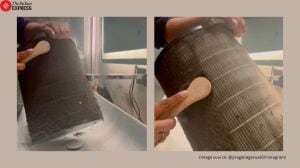Gas sector: Tariff cut and after
Petroleum and Natural Gas Regulatory Boards decision to cut IGLs tariffs has de-rated the downstream gas sector.
Petroleum and Natural Gas Regulatory Boards (PNGRBs) decision to cut IGLs (Indraprastha Gas) tariffs has de-rated the downstream gas sector. In the current scenario,GAIL emerges as the best play as its exposure to non-transmission segment (40% of Ebit) makes it less vulnerable to regulatory shocks.
IGL would continue to underperform due to uncertainty over its future earnings. Despite good long-term prospects,GSPL (Gujarat State Petronet) would face overhang of similar stringent policy action for its Gujarat tariffs (notification expected in 4-5 months). While risk to PLNGs (Petronet LNG) re-gas margin has amplified,GGAS (Gujarat Gas) is less vulnerable because of its lower margin vs. IGL.
GAILbest placed in uncertain regulatory environment GAIL is better placed than peers as (a) non-transmission segment (40% of Ebit) is less vulnerable to regulatory shocks and (b) doubling of petchem capacity by FY14 would provide long-term earnings growth. However,we reduce our target price to R390 vs. 425 earlier to factor in higher risk to its transmission business.
IGLto underperform on earnings uncertainty IGL would underperform due to uncertainty over future earnings. Also,retrospective adjustment in tariffs may potentially lead to one-time refund of R12 bn (90% of FY12 net worth). We are placing IGL Under Review. We will revisit our estimates after we get clarity on how cut in tariffs would be implemented. Our bear-case valuation of R190/share assumes (a) retrospective adjustment in tariffs and (b) gross margin at R5/scm till FY40.
GSPLoverhang of similar policy action in Gujarat tariffs While we remain confident of GSPLs long-term prospects,stock is likely to remain under pressure in the short term on concerns over possibility of similar stringent action for its Gujarat tariffs. Our revised target price of R95 vs. R110 earlier implies 34% upside. Our bear-case valuation of R65/share based on 0.8x FY14e BV (book-value) of R67/share and investments of R11/share.
PLNGrisks to re-gas margin amplified No impact on our target price (R170) as our estimates factor in a cap on their re-gasification margin post FY14.
Gujarat Gasless vulnerable to policy action as margin low GGAS margin is low at R5/scm (35% discount to IGLs margin). BG stake sale would also support stock price. However,we cut our TP (target price) to R370 (R405 earlier) to factor in the regulatory overhang.
IGL: Scenario analysis
Bear case valuation at R190 per share We have assumed retrospective adjustment in tariffs would lead to onetime refund of R12 bn (90% of FY12 net worth). This would lead to IGL reporting loss of R46/sh in FY13e. We assume IGLs gross margin at R5/scm (network,compression tariff of R3.5/scm + marketing margin of R1.5/scm) through the life of assets. Base case valuation at R240 per share Under the base case scenario,we have assumed IGL would not pay retrospective tariff adjustments. Gross margin at R5/scm over FY13-14e and at R6/scm from FY15e due to revision in tariff structure.
CGD Network
CGD (city gas distribution) network: Tariff determination for existing players
Network tariff and compression charges to be determined on RoCE-based DCF (discounted cash flow)
14% post-tax RoCE (return on capital employed) over the economic life of the project (25 years)
RoCE to be calculated separately for CGD infrastructure and compression infrastructure
Asset life of 25 years; reviews after a block of 5 years
Company,regulator,buyers can request PNGRB (Petroleum & Natural Gas Regulatory Board) for a mid-block review.
Capital employed defined as sum of net block and normative working capital
Net block would be gross block less depreciation (based on specified depreciation rate as per Companies Act)
Most companies using 3.17% as applicable depreciation rate for a 30 year project life
Working capital defined as 20 days of operating expenses excluding depreciation
Normative capex for maintenance and upgradation of pipeline infrastructure
Interstate trans-mission pipelines
Interstate transmission pipelinesTariff determination for existing players
Network tariff to be determined on RoCE-based DCF
12% post-tax RoCE over the economic life of the project (25 years)
Asset life of 25 years; reviews after a block of 5 years
Company,regulator,buyers can request PNGRB for a mid-block review
Tariffs to be fixed based on provisional basis first and then finalize as per actual Capital employed sum of net block and normative working capital
Net block is gross block less depreciation (based on specified depreciation rate as per Companies Act)
Most companies use 3.17% as applicable depreciation rate for a 30 year project life
Working capital defined as 30 days of operating expenses and 18 days of tariff receivables
Normative capex (capital expenditure) for maintenance and upgradation of pipeline infrastructure
Volumes: Lower volumes in earlier years ensures adequate profitability to operators
Volumes of gas to be considered for calculation of tariff increases from 60% of normative capacity in first year to 100% of normative capacity fifth year onwards
Silent on spot volumes: Opportunity for operators to earn higher returns.
Enam






- 01
- 02
- 03
- 04
- 05

























